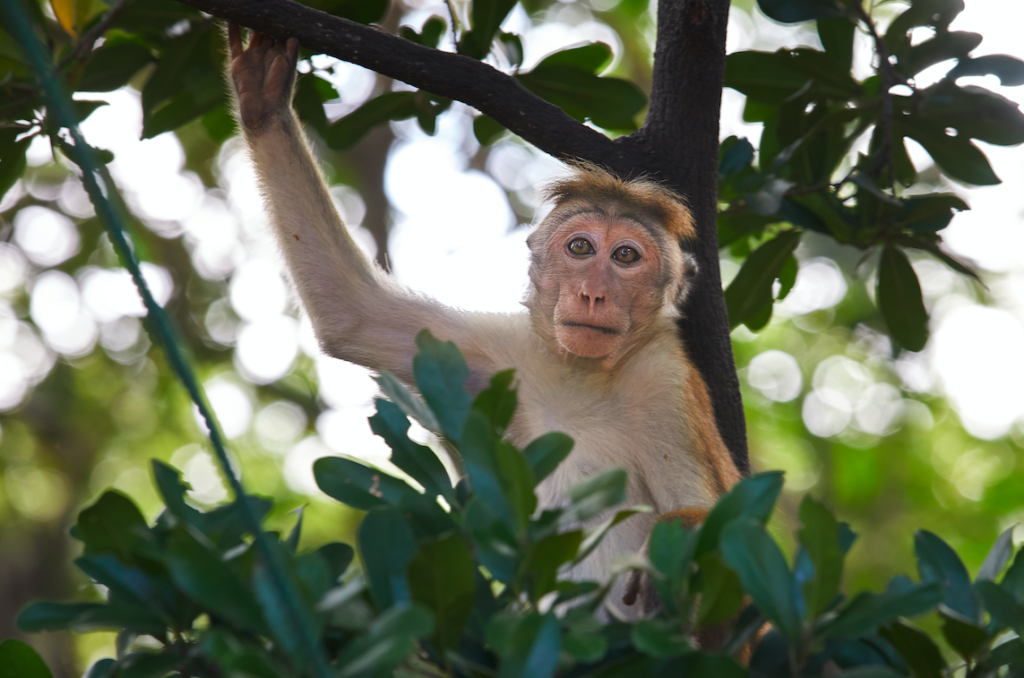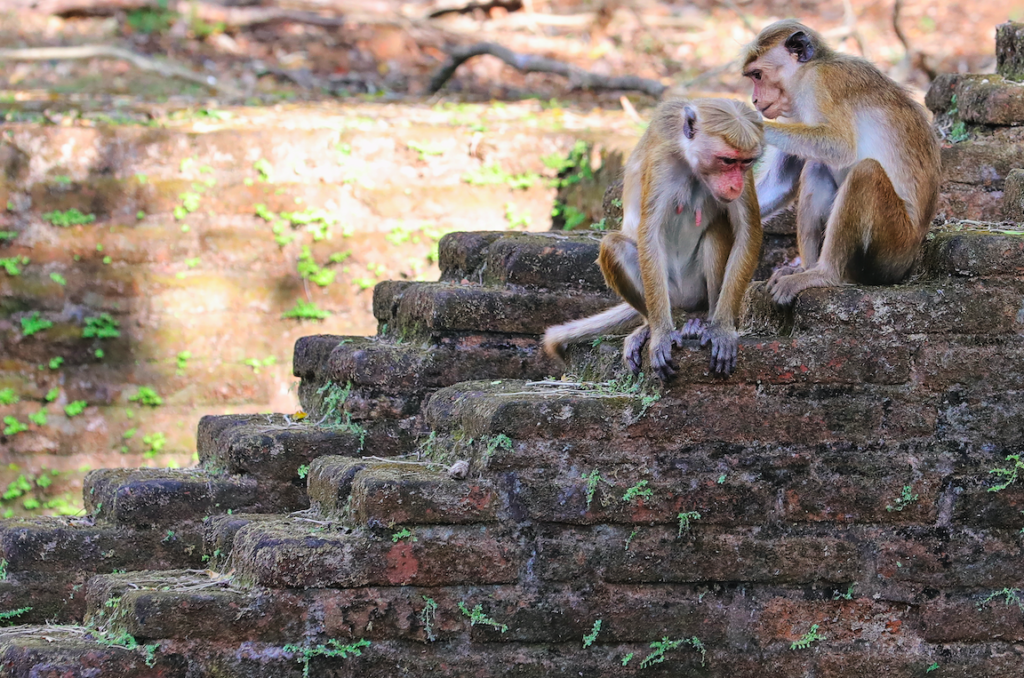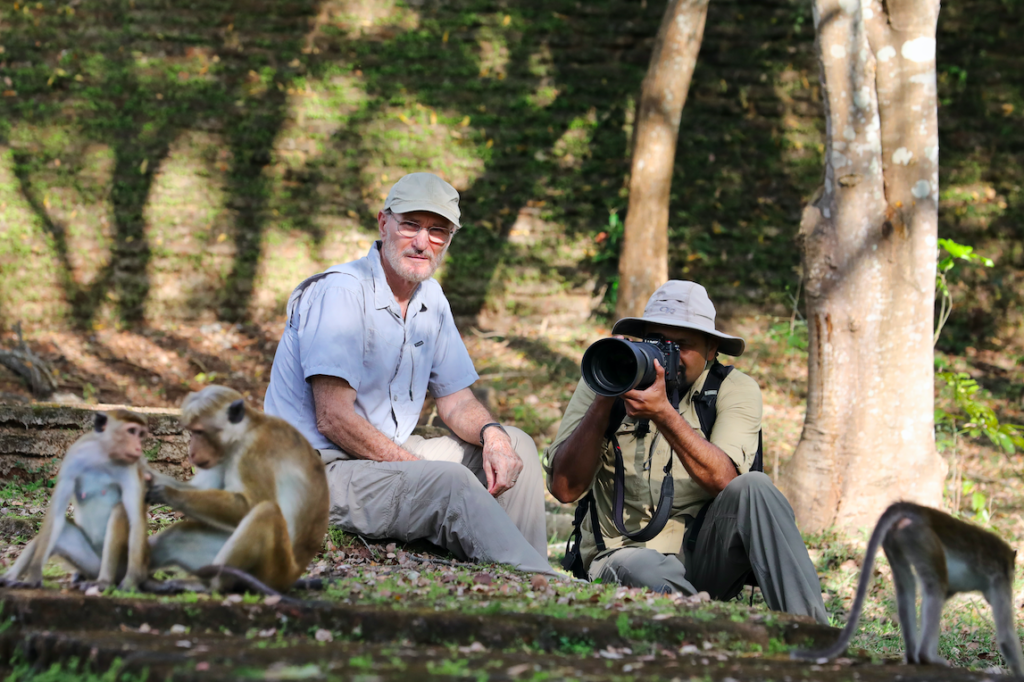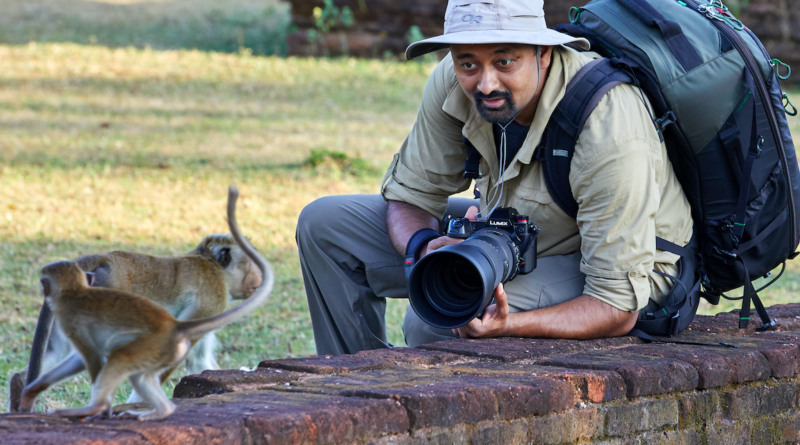INTERVIEW: Sandesh Kadur on his journey to film the monkeys of Sri Lanka
Photo: Sandesh Kadur approaches a primate in the ancient city of Polonnaruwa, Sri Lanka. Photo courtesy of National Geographic / Ritam Banerjee / Provided by press site with permission.
Nat Geo and Nat Geo WILD are celebrating Earth Day’s 50th anniversary with a special program highlighting animal babies around the world. Born Wild: The Next Generation is set to premiere Wednesday, April 22 at 8 p.m. on the two networks, with streaming available on Disney+ and Hulu.
One of the powerful voices on this hour-long documentary is Sandesh Kadur, a National Geographic Explorer and senior fellow of the International League of Conservation Photographers, according to his official biography. His assignment for the TV special was to capture the baby primates in the ancient city of Polonnaruwa, Sri Lanka. What he finds is a veritable monkey kingdom, with macaques and langurs holding down the fort, swinging, eating and playing around the ruins of a crumbling Buddhist temple.
For Kadur, whose work has been seen on BBC’s Planet Earth II and Nat Geo WILD’s Earth Live, his relationship with National Geographic has been life-changing, allowing him to see the world and feed his inquisitive mind.
“The first time I did anything with National Geographic was about 11 years ago,” Kadur said recently while staying home in India during the coronavirus pandemic. “In 2008 and 2009, I made a documentary for them about king cobras in the Western Ghats of India, and that was the beginning of a long-term relationship with National Geographic, National Geographic Society, as well as the channel.”
[Read Hollywood Soapbox’s interview with fellow National Geographic Explorer Brian Skerry.]
Kadur has always had a love of nature, animals and conservation. He said that without this adoration for the environment and its many species, his job would be pointless. In order for a wildlife cinematographer or photographer to excel, they must appreciate the wonders of planet Earth.
“I don’t think you can get into this field if you don’t have that inherent love for nature, the outdoors and wanting to always be a part of that whole ecosystem,” he said. “I can go all the way back to my early teenage years when I used to go sit up on a tree and wait for leopards and elephants to come drink at a water hole. All I wanted to do was just watch animals in the wild, so now with a camera, I have an official job and a title to actually justify going and spending all of this time. It’s a great excuse to spend all my time outdoors, so this lockdown has been quite a time in my life. I’ve never actually spent so much time indoors. I can sit in a hide for 40 days, but sitting at home has been a very different story.”



Kadur’s shoot in Sri Lanka was actually cut short by one day because of the pandemic. He needed to quickly complete his filming of these primate species and rush home to India before the country closed its doors to international flights. Luckily, he had captured almost all of the footage he was seeking, and the fruits of his labor will be on display in Born Wild.
“It was the first time I had ever been to Sri Lanka, and I love filming or being part of anything that’s so new,” Kadur said. “For me, the best part was spending time in a new country, a new place, although the animals were familiar. We have a very similar monkey here called the bonnet macaque, and I was filming the toque macaque. And then we have the same lungur species, so it was nice to be part of an ecosystem that was strangely very familiar and yet very different because the monkeys I was actually filming there are endemic to that one island and not found anywhere else in the world. So although we have similar species in India, they’re not the same at all.”
Kadur said he is amazed that many of these primate species are able to adapt to different environments, including living in and around (and sometimes on top of) human structures. In India, for example, macaques can be seen in their wild ancestral ground, hanging out near trees and foraging for fallen fruit. They can also be found swinging on people’s porches or scaling the heights of parliamentary buildings in New Delhi. These monkeys have adapted to life alongside human communities, for better or worse.
“I’ve spent enough time away from India to come back to India and be amazed that there is so much wildlife in the cities and all around, and people actually tolerate having these cheeky monkeys all around them,” Kadur said. “And it’s really this connection to mythology and to the whole legend with the Monkey God that allows this inherent tolerance for animals all around. Otherwise, I cannot imagine a country with 1.3 billion people be surrounded by animals, so it was nice to see the very same respect for these animals in Sri Lanka. Over there as well the local people really tolerate them, and allow them their space and allow them their freedom to be as they are.”
For his Sri Lankan journey, Kadur was joined by Professor Wolfgang Dittus, a primatologist at the Smithsonian Conservation Biology Institute’s Conservation Ecology Center who has been studying these species for decades. When they arrived in Sri Lanka, which is an island nation located to India’s south, the actually cinematography work wasn’t too difficult because several of the primates were in abundance and hung out near the ground.
[Read Hollywood Soapbox’s interview with Dr. Jane Goodall.]
“Unlike the langur, the other monkey with a long tail, the macaques are actually fairly terrestrial,” Kadur said. “They do come down to the ground and feed on fallen fruit and things like that, so they are very adept on the ground. So we were able to film them at ground level and at low tree level, unlike the langurs, which were always high up. Because the basic difference between the macaques and the langurs is that the langur has a very elaborate digestive system. It has a multi-chambered stomach, so it can actually digest leaves and has special bacteria that can help them digest leaves, which the macaques don’t. So they need to eat food more like what we do, and they forage on the ground for fruits and things because they cannot eat leaves.”
He added: “And also because these animals have not been persecuted by humans, they don’t fear us in any way, so humans have been part of that landscape and part of that ecosystem. There’s a very beautiful relationship with the monkeys and humans, so they don’t run away. They’re not scared, so you can go and sit right up close to them. You’re not affecting their behavior, and they don’t bother you. So you can get some beautiful, intimate shots without any problems, so in terms of the filming assignment, I would definitely say it was one of the easier ones I’ve been on.”
Now, thanks to Kadur, audience members of Born Wild: The Next Generation will have a chance to sit next to these monkeys as well.
By John Soltes / Publisher / John@HollywoodSoapbox.com
Born Wild: The Next Generation, featuring Sandesh Kadur, will air Wednesday, April 22 at 8 p.m. on Nat Geo and Nat Geo WILD, with streaming available on Disney+ and Hulu. Click here for more information.

